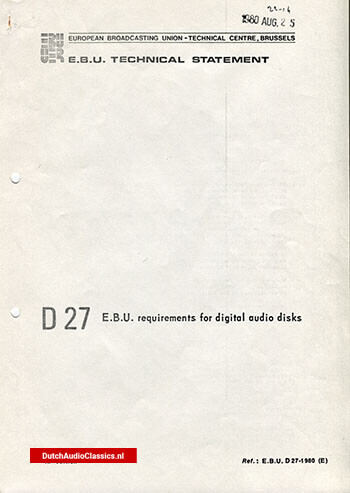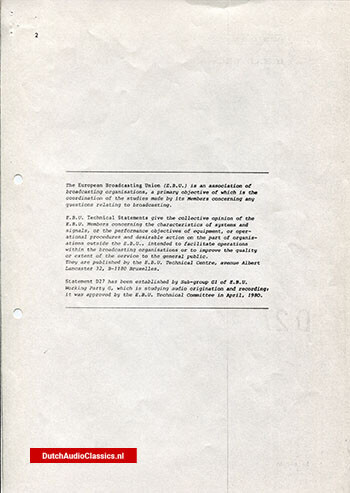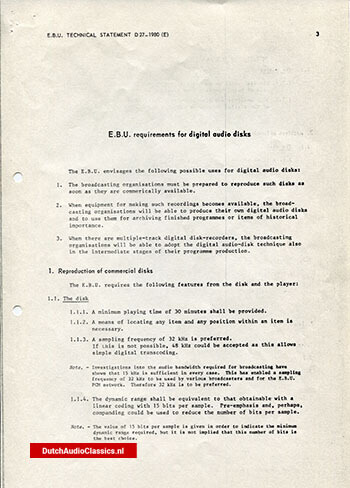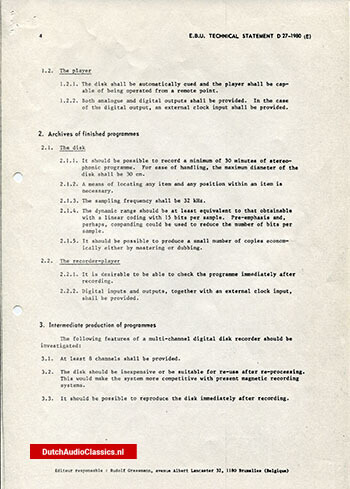The European Broadcasting Union (E.B.U.) is an association of broadcasting organisations, a primary objective of which is the coordination of the studies made by its Members concerning any questions relating to broadcasting.
Statement D27 has been established by Sub-group G1 of E.B.U. Working Party G, which is studying audio origination and recording: it was approved by the E.B.U. Technical Committee in April, 1980.
E.B.U. Technical Statements give the collective opinion of the E.B.U. Members concerning the characteristics of systems and signals, or the performance objectives of equipment, or oper¬ational procedures and desirable action on the part of organis¬ations outside the E.B.U., intended to facilitate operations within the broadcasting organisations or to improve the quality or extent of the service to the general public.
They are published by the E.B.U. Technical Centre, avenue Albert Lancaster 32, B-1180 Bruxelles.
E.B.U. requirements for digital audio disks
The E.B.U. envisages the following possible uses for digital audio disks:
- The broadcasting organisations must be prepared to reproduce such disks as soon as they are commerically available.
- When equipment for making such recordings becomes available, the broad-casting organisations will be able to produce their own digital audio disks and to use them for archiving finished programmes or items of historical importance.
- When there are multiple-track digital disk-recorders, the broadcasting organisations will be able to adopt the digital audio-disk technique also in the intermediate stages of their programme production.
1. Reproduction of commercial disks
The E.B.U. requires the following features from the disk and the player:
1.1. The disk
- 1.1.1. A minimum playing time of 30 minutes shall be provided.
- 1.1.2. A means of locating any item and any position within an item is necessary.
- 1.1.3. A sampling frequency of 32 kHz is preferred. If this is not possible, 48 kHz could be accepted as this allows simple digital transcoding.
Note. — Investigations into the audio bandwidth required for broadcasting have shown that 15 kHz is sufficient in every case. This has enabled a sampling frequency of 32 kHz to be used by various broadcasters and for the E.B.U. PCM network. Therefore 32 kHz is to be preferred. - 1.1.4. The dynamic range shall be equivalent to that obtainable with a linear coding with 15 bits per sample. Pre-emphasis and, perhaps, companding could be used to reduce the number of bits per sample.
Note. — The value of 15 bits per sample is given in order to indicate the minimum dynamic range required, but it is not implied that this number of bits is the best choice.
1.2. The player
- 1.2.1. The disk shall be automatically cued and the player shall be cap-able of being operated from a remote point.
- 1.2.2. Both analogue and digital outputs shall be provided. In the case of the digital output, an external clock input shall be provided.
2. Archives of finished programmes
2.1. The disk
- 2.1.1. It should be possible to record a minimum of 30 minutes of stereo-phonic programme. For ease of handling, the maximum diameter of the disk shall be 30 cm.
- 2.1.2. A means of locating any item and any position within an item is necessary.
- 2.1.3. The sampling frequency shall be 32 kHz.
- 2.1.4. The dynamic range should be at least equivalent to that obtainable with a linear coding with 15 bits per sample. Pre-emphasis and, perhaps, companding could be used to reduce the number of bits per sample.
- 2.1.5. It should be possible to produce a small number of copies econom-ically either by mastering or dubbing.
2.2 The recorder-player
- 2.2.1. It is desirable to be able to check the programme immediately after recording.
- 2.2.2. Digital inputs and outputs, together with an external clock input, shall be provided.
3. Intermediate production of programmes
The following features of a multi-channel digital disk recorder should be investigated:
- 3.1. At least 8 channels shall be provided.
- 3.2. The disk should be inexpensive or be suitable for re-use after re-processing. This would make the system more competitive with present magnetic recording systems.
- 3.3. It should be possible to reproduce the disk immediately after recording.



